Dr. Eytan Ruppin of the National Cancer Institute in the United States recently completed research on predictive indicators for the efficacy of PD-1 and PD-L1 monoclonal antibodies. This very valuable research result was published in JAMA Oncology in August this year.
In the research, he first obtained two data:
(1) The entire exon gene and RNA sequence of 7187 cancer patients in the cancer gene map;
(2) Objective response rate (ORR) of PD-1 or PD-L1 monoclonal antibody clinical trials for 21 cancers.
After systematically evaluating 36 variables (divided into 3 levels) related to neoantigens, immune checkpoints, and immune responses, the study concluded that the abundance of CD8+ T cells is the main indicator for predicting efficacy ( Spearman R = 0.72; P <2.3 × 10−4), followed by the degree of tumor mutation (Spearman R = 0.68; P <6.2 × 10−4) and the high expression of PD-1 gene in the specimen (Spearman R = 0.68; P <6.9 × 10−4). Considering the combination of immunization, neoantigens, and immune checkpoint targets, the ORR of more than 80% of the treatments can be predicted more accurately. But he also admitted that the predictive indicators may be different in different tumor types. For example, for malignant tumors such as malignant melanoma and kidney cancer, the abundance of CD8+ T cells is the most reliable predictor. However, due to the lack of standardization of this test, this test in many hospitals is very unstable and unreliable. It has lost clinical value and should be improved as soon as possible. When asked how many data on East Asian patients are in the oncogene map, he admitted that it accounts for a small percentage of the data. Clinical practice has proved that the abundance of CD8+ T cells is very important in the treatment of malignant tumors. The data also shows that when antigen-specific CD8+ T cells are combined with PD-1 monoclonal antibody, the efficacy is significantly improved. Unfortunately, toxic side effects have also been significantly increased, especially for cytokine release disorders. Therefore, reducing the toxic and side effects of anti-PD-1 and PD-L1 monoclonal antibody therapy is still a clinical problem that needs to be resolved urgently.
Reference article
